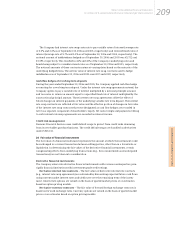Siemens 2006 Annual Report Download - page 213
Download and view the complete annual report
Please find page 213 of the 2006 Siemens annual report below. You can navigate through the pages in the report by either clicking on the pages listed below, or by using the keyword search tool below to find specific information within the annual report.
Notes to Consolidated Financial Statements
(in millions of €, except where otherwise stated and per share amounts) 209
The Company had interest rate swap contracts to pay variable rates of interest (average rate
of 5.0% and 2.4% as of September 30, 2006 and 2005, respectively) and received fixed rates of
interest (average rate of 5.7% and 5.3% as of September 30, 2006 and 2005, respectively). The
notional amount of indebtedness hedged as of September 30, 2006 and 2005 was €5,752 and
€3,595, respectively. This resulted in 44% and 45% of the Company’s underlying notes and
bonds being subject to variable interest rates as of September 30, 2006 and 2005, respectively.
The notional amounts of these contracts mature at varying dates based on the maturity of the
underlying hedged items. The net fair value of interest rate swap contracts used to hedge
indebtedness as of September 30, 2006 and 2005 was €207 and €259, respectively.
Cash flow hedges of revolving term deposits
During the years ended September 30, 2006 and 2005, the Company applied cash flow hedge
accounting for a revolving term deposit. Under the interest rate swap agreements entered, the
Company agrees to pay a variable rate of interest multiplied by a notional principle amount,
and to receive in return an amount equal to a specified fixed rate of interest multiplied by the
same notional principal amount. These interest rate swap agreements offset the effect of
future changes in interest payments of the underlying variable rate term deposit. The interest
rate swap contracts are reflected at fair value and the effective portion of changes in fair value
of the interest rate swap contracts that were designated as cash flow hedges are recorded in
AOCIas a separate component of shareholders’ equity. Net cash receipts and payments relating
to such interest rate swap agreements are recorded as interest income.
Credit risk management
Siemens Financial Services uses credit default swaps to protect from credit risks stemming
from its receivables purchase business. The credit default swaps are classified as derivatives
under SFAS 133.
26 Fair value of financial instruments
The fair value of a financial instrument represents the amount at which the instrument could
be exchanged in a current transaction between willing parties, other than in a forced sale or
liquidation. In determining the fair values of the derivative financial instruments, certain
compensating effects from underlying transactions (e.g., firm commitments and anticipated
transactions) are not taken into consideration.
Derivative financial instruments
The Company enters into derivative financial instruments with various counterparties, prin-
cipally financial institutions with investment grade credit ratings.
Derivative interest rate contracts – The fair values of derivative interest rate contracts
(e.g., interest rate swap agreements) are estimated by discounting expected future cash flows
using current market interest rates and yield curve over the remaining term of the instru-
ment. Interest rate options are valued on the basis of quoted market prices or on estimates
based on option pricing models.
Derivative currency contracts – The fair value of forward foreign exchange contracts is
based on forward exchange rates. Currency options are valued on the basis of quoted market
prices or on estimates based on option pricing models.
Notes to Consolidated Financial Statements
























